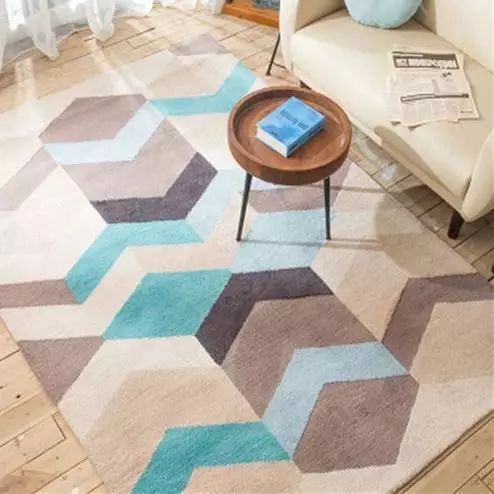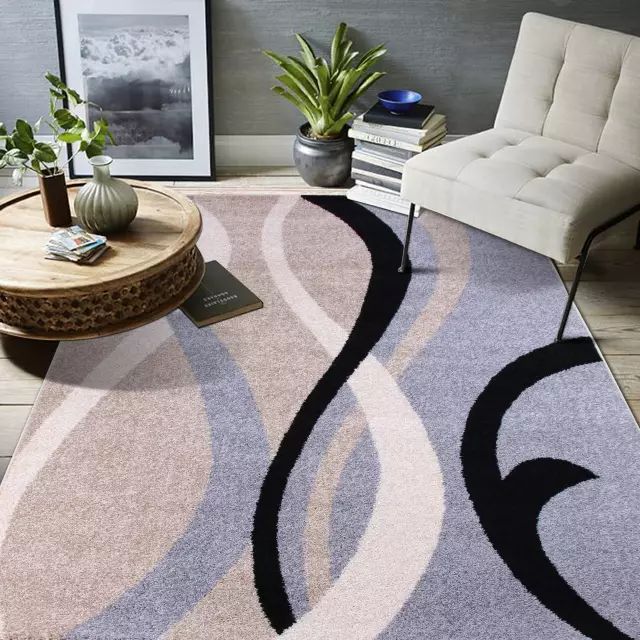New Zealand wool, domestic wool, British high-quality four-star wool, Australian wool
DuPont nylon, Shouno nylon, BASF nylon, 6.6 nylon - its yarn is 98% nylon and 2% carbon polymer (conductive yarn) Chemical fiber carpet (P.P) polypropylene fiber, polyester, acrylic, polypropylene, imported PP needs heat-setting treatment.

Hand woven carpet, fine workmanship, colorful patterns, mostly used for pure wool carpet.
Carpet weaving type non-woven carpet adopts non-woven manufacturing technology, i.e. the raw material is made directly into fabric by weaving method without the traditional spinning process. Therefore, non-woven carpets are short wool carpets without warp and weft weaving, such as needle-punched carpets and bonded carpets. This kind of carpet glues the pile on the backing of rubber or hemp backing. The process is simple and the cost is low, but the carpet is thin, the footing is poor, and the durability and elasticity are also rented poor.
Tufted carpet is woven by tufting method, divided into flat pile carpet and loop pile carpet. Loop pile carpet does not cut the pile circle in the weave, the surface is one circle after another, the pile height is 5~10mm. After cut pile treatment, it is flat pile carpet, the pile height is mostly 7~10mm.

Good elasticity, not easy to pollution, deformation, wear and tear, good heat insulation, easy to corrosion, insects, higher price.
Wear-resistant, easy to clean, no corrosion, no insects, no mildew, but easy to deformation, easy to generate static electricity, will be partially dissolved in case of fire.
Abrasion resistance is second only to nylon, heat-resistant, sun-resistant, not moldy, not insects. Dyeing is difficult.
Light weight, good elasticity, high strength, abundant raw materials, low production cost.
Soft, warm, good elasticity, the elastic recovery force in the low elongation range is close to that of wool, lighter than wool, not moldy, not corrosive, not moth-eaten, the disadvantage is poor abrasion resistance.

The standard is that the higher the number of warp threads in each 0.3048 square meter carpet, the better the quality, generally the carpet for family use is 90~150 channels, the carpet used in high-grade decoration should be more than 200 channels, even up to 400 channels.
The number of times the carpet needs to be exposed to the backing by wear and tear under fixed pressure The wear resistance of the carpet is related to the variety of raw materials and the thickness of the carpet weave, the thicker the more wear resistance.
The thickness loss rate of the carpet under dynamic load is expressed, that is, the carpet is pressurized, and after a certain time, the pressure is removed and the thickness difference between the carpet and the unpressurized carpet is measured, and the rebound ability of the pile on the surface of the carpet is favored.
The thicker and smaller the difference, the better the resilience. The resilience is tested as follows: wool, eyeliner, nylon, polypropylene. Of course, due to different origins, different levels of technology, especially the emergence of many reborn products, this sort will also change.
The carpet charged and discharged, measured by the carpet surface resistance and static voltage, is generally related to the electrical conductivity of the fiber itself The chemical fiber carpets produced at present are treated and will have no effect on the use.
For chemical fiber carpet, if the burning time is within 12 minutes and the diameter of the burning area is within 17.96 cm, the flame resistance is qualified. In comparison, polypropylene carpet is poorer in flame-resistance, while other carpets are not much related to flame-resistance index. Of course, in addition to flame-resistance, we should also pay attention to the problem that chemical fiber carpet is easy to produce damage gas after burning.

The quality of carpet products is mainly determined by the test data, but also by some simple empirical selection methods.
You can touch the carpet by hand, the pile head quality of its products is high, the density of the carpet surface is rich, so the carpet is good elasticity, pedal resistance, wear resistance, comfortable and durable.
Here, we remind consumers not to take the method of picking long pile to select carpet, which looks good on the surface, but the density of pile head is loose, and the pile head is easy to fall down and deform, so the carpet is not resistant to stepping, easy to lose the unique performance of carpet, not durable.
According to the different laying occasions, choose the carpet of different manufacturing process. The carpet with high quality and density of pile head per unit area, otherwise the sparse pile head will cause the change of flower pattern and pile head fall.
Colorful carpet, soft texture, beautiful and generous.
When choosing carpet, you can rub your hand or test cloth on the carpet surface several times to see if there is color sticking on your hand or test cloth. If there is color sticking, it means that the color fastness of the product is not good, which will cause the carpet to change color and lose color easily in laying and use, and affect the beautiful effect of the carpet in laying and use.
The back of the tufted carpet has a grid backing with latex, and the peeling strength of the backing according to the standard is ≥25N. Consumers can gently tear the backing by hand to see the degree of adhesion when selecting this type of carpet, if the adhesion is not high, the backing is easy to separate from the carpet body, so the carpet is not durable.
Consumers in the selection of carpet, to check whether the carpet surface is flat, whether the carpet edge is straight, whether there are defects, oil spots, color difference, especially when buying tufted carpet to check whether the carpet backing off, seepage of glue and other phenomena, to avoid the carpet in the use of paving drum, inequality, and lose comfortable, beautiful effect.

When it comes to carpet durability, fiber selection plays a key role. There are five basic categories of carpet fibers, with wool and nylon emerging as the most durable options. Let's take a closer look at these fiber types and their properties:
1. Wool:
The Benchmark of Luxury and Performance: Wool is the pinnacle of luxury and performance in the rug world.
Softness: It is softer than its synthetic counterparts.
Superior Durability: Wool rugs are extremely durable and offer excellent stain resistance.
2. Nylon:
Durability and Feel: Nylon is a close second to wool in terms of durability and provides a pleasant feel underfoot.
Cost: Relatively more affordable, with prices ranging from $18 to $35 per square yard.
Properties: Nylon offers excellent stain resistance, color fastness and elasticity.
Market Share: Nylon dominates the market, accounting for nearly 60% of carpet sales.
Enhanced products: Some nylon rugs are more resistant to wear and stains. Some models use carbon composite nylon wire to eliminate static shock, but the price is higher.
3. Olefin (polypropylene):
Durability and Resistance: Olefin is known for its durability, water resistance, and stain resistance, making it suitable for Berber rugs and indoor/outdoor rugs as well as commercial settings.
Elasticity: However, it is not as elastic as nylon and is best suited for low-pile carpets to prevent kinking or pinching.
4. Polyester:
Soft texture: Polyester is known for its soft texture, especially when used in a thick, luxurious pile.
Color retention: Good color retention and stain resistance.
Elasticity: Polyester is not as elastic as nylon.
5. Acrylic:
Wool-like appearance: Acrylic has a wool-like appearance but is less expensive, ranging from $10 to $15 per square yard.
Fiber Properties: However, acrylic fibers are prone to linting and pilling, so are less common in room-size rugs.
Moisture and Mildew Resistant: Acrylic is often found in bathroom rugs due to its moisture and mildew resistant properties.
Carpet surface weight and durability:
Face weight, which refers to the weight of carpet pile per square yard, is another factor to consider for durability. A higher face weight means more yarn and generally a longer product life. For example, a "best level" carpet might have a surface weight of 63 ounces, while a "good level" carpet might have a surface weight of 40 ounces. However, face weight should be compared between similar products because different fibers have different performance qualities.
In summary, choosing the most durable rug depends on your specific needs, budget, and preferences. Wool and nylon are the top choices for durability, but other fibers like polyester and olefin have their advantages. Additionally, understanding pile pattern and surface weight can further help you choose the right rug for your space.
Substrate cleaning treatment → carpet cutting → nail barbed board → pavement layer → seam → flattening → fix carpet → edge → repair carpet surface → cleaning.
The common quality defects of carpet paving are drumming, skirt wrinkling, inconsistent color and carpet loosening, drumming, and durring. In addition to the carpet is not paved flat before paving, the main reason is the unevenness of the spreader tension and the individual failure to catch the barbs in the barbed plate when paving. If the carpet is opened and bulged, the carpet should be rolled over and paved flat. When spreading the carpet, make sure that all the barbs can catch the carpet.

The reason is not only the bad quality of the material, but also the color change of the carpet after water absorption due to wet surface or water seepage, as well as the color change of the carpet surface due to sunlight exposure. Pay attention to the carpet with good quality and consistent color when purchasing. Avoid water on the carpet in use, and do not pave the carpet on the ground that is easy to catch water. Avoid direct sunlight or construction in harmful gas environment, and avoid direct sunlight in daily use.
The main reason is that the barbs on the barbed plate cannot be fixed. The barbed plate should be configured as required and ensure that the barbs all catch the carpet.
If you're ready to transform your living space into a haven of luxury and style, don't wait any longer. Visit Beijing Home Interiors Co., Ltd.today and explore their stunning collection of carpets. Elevate your home's interior with the timeless beauty and comfort that only their carpets can provide. Make the right choice – contact us now! and turn your home into a masterpiece of design and comfort.